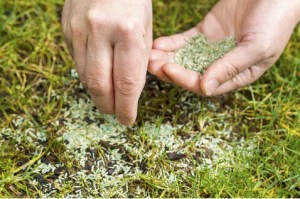Winter is here and knowing how to prepare your lawn for the coming spring and summer is essential to having the lush yard of your dreams. After a long summer of use, autumn and winter is the time to repair the damage from normal wear and tear. Here are six tips to preparing your front lawn for winter:
Mowing Your Yard

Many homeowners mistakenly set a singular stopping date for mowing their yard at the end of the season. While it is true that warm season grasses go dormant in cold weather, cool season grasses continue to grow at a slow pace until the ground has frozen. This means that specifically in areas with cool season grasses, it is best to keep a consistent mowing cycle of 10-14 days until that point. Keep your mower on its lowest setting to clear out any yard debris such as leaves and prevent parts of your yard from being smothered. Keeping the grass short will also help reduce the incidence of fungus damage caused in areas that receive snow.
Aerate The Grass

Aeration is, most simply put, promoting air supply to the roots of the grasses and increasing drainage in your yard. If your yard gets constant use and is compacted, consider doing this once or twice each year. If your yard is a showpiece, however, save your time and effort and do this one every other year. There are simple tools available (hollow tine aerators) to help with the job.
Seed

Fall is the perfect time to seed your yard so that the roots grow intensely in the fall and winter months. For that lush, green lawn you’ve always wanted, do not choose the cheapest seed or you’ll find it may grow until the ground frosts and then die. A good Kentucky Bluegrass seed will stand up to the winter and resist disease, insects, and the cold.
Fertilization

Image by Ben Rollins
You need to eat and so does your lawn! Best in late fall, typically a month before the ground freezes, fertilization will help your grass (especially that new seed you spread) weather the winter and grow lush in the spring. For root growth, choose a fertilizer that is rich in phosphorus. In some states, phosphorus-rich fertilizers are being banned due to harm to watershed, in which case a nitrogen-rich fertilizer will get the job done and promote root and shoot growth.
Mulching

Instead of the arduous task of raking and bagging leaves from your yard, consider running them over with your mower as mentioned above in the “Mowing Your Yard” section. A simple mulching blade that attaches to your lawnmower will ground the leaves up even finer and give a layer of protection to your yard from the winter, as opposed to smothering it like whole leaves do.
Weed Control

You spent all spring and summer carefully planning and creating your landscaping and fall is the opportune time for weed control. Like any plant, during the fall weeds are gathering as much sunlight and as many nutrients from the soil as they can. Take advantage of this natural course of events and spray a good weed killer, allowing the natural cycle of the weeds to do your dirty work for you.
Bonus Tip!

During the winter, be sure to turn off your lawn sprinkler system and drain the lines. This will prevent any freezing damage during the winter and keep your sprinkler system in tip-top shape for the coming spring!
Taking these simple steps to prepare and protect your lawn for the winter will give you the perfect lush yard you want next spring and summer. Have you taken any other steps to protect your lawn? Share your techniques with us!
Getting ready for winter? NVS Landscapes offers snow removal and plowing services. Contact us if using the form below if you’re interested in a quote, or give us a call:

Leave a Reply